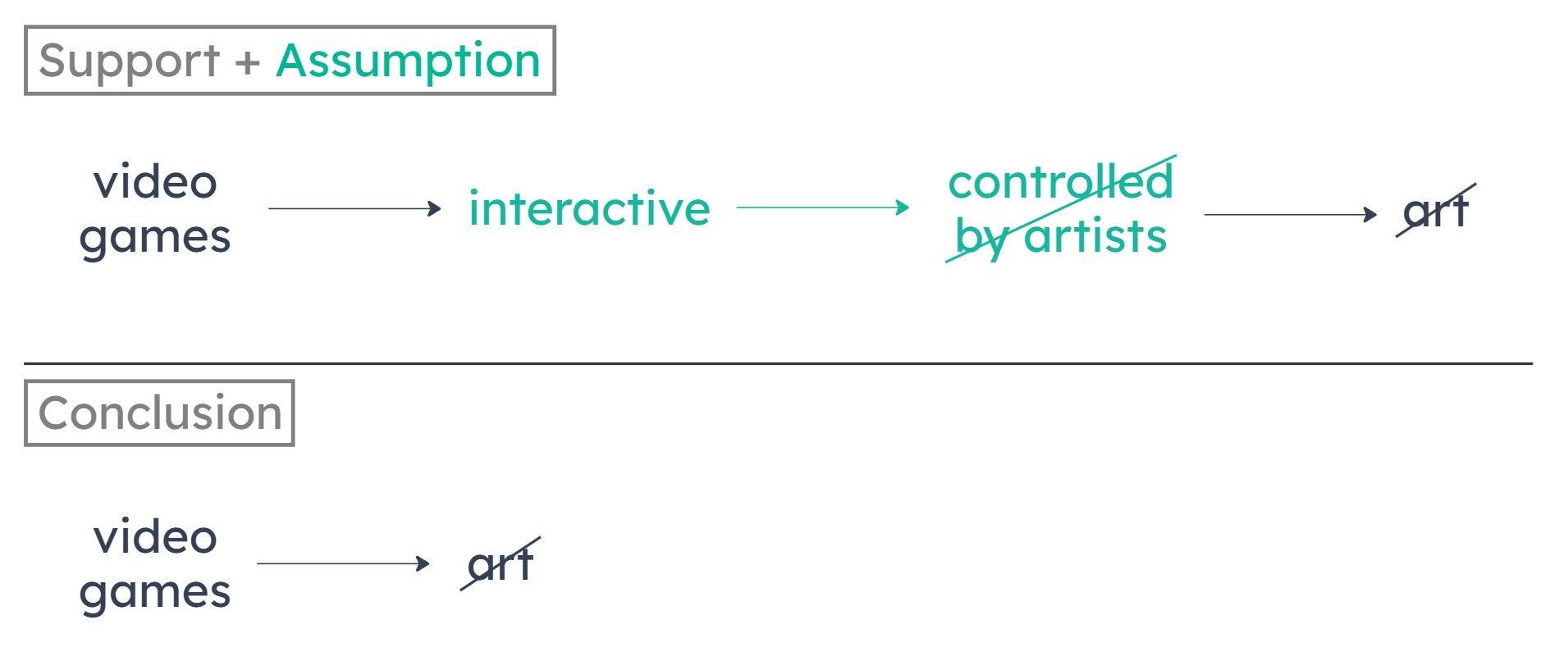Summary
Video games aren’t art. Why not? Because they’re interactive experiences. Art, meanwhile, must be an experience controlled by its creators. (Contrapositive: if it’s not controlled by its creators, it’s not art.)


Missing Connection
We know that something fails to be a work of art whenever it’s not controlled by its creators. But what does that have to do with video games? All we know about video games is that they’re interactive. Does being interactive mean the experience isn’t controlled by its creators? The author doesn’t say.
The conclusion would follow if we knew for sure that when an aesthetic experience is interactive, it’s not at all controlled by its creators.
The conclusion would follow if we knew for sure that when an aesthetic experience is interactive, it’s not at all controlled by its creators.
A
Most video game creators do not intend their video games to be works of art.
Intentions are irrelevant. None of the premises suggest that a creator’s intentions have any influence on whether something is art. Also, any assumption about “most” video game creators will be too weak to guarantee the conclusion that no video games are art.
B
An aesthetic experience cannot be both interactive and controlled by the artist or artists who created the work.
This says that if an aesthetic experience (such as a video game or work of art) is interactive, then it’s not controlled by its creators. We know that video games are interactive, so the conclusion now follows: video games aren’t controlled by their creators, so they’re not art.


C
For something to be a work of art, it must produce a rich aesthetic experience.
Contrapositive: if something doesn’t produce a rich aesthetic experience, it’s not art. But do all video games produce a rich aesthetic experience? We don’t know. So (C) doesn’t lead us to the conclusion.
D
Typically, video game players do not themselves create video games.
An assumption about what’s typical will be too weak to guarantee the conclusion that no video games are art. Also, whether or not a player also happens to create games tells us nothing about whether the things a player experiences are controlled by the game’s own creators.
E
Players’ choices that have no effect on the outcome of a video game are irrelevant to the aesthetic experience produced by that game.
What matters about a game’s aesthetic experience is whether it’s controlled by the game’s creators. (If not, then games aren’t art.) (E) doesn’t tell us anything about creator control. In fact, it doesn’t tell us anything that’s relevant to aesthetic experience at all.
Summarize Argument
The author concludes that if a piece sold as amber contains an insect that looks normal, it is more likely to be fake than if the amber doesn’t contain a normal-looking insect. The author supports the argument by establishing that forgers often add normal-looking insects to fake amber in order to make more money.
Notable Assumptions
The author assumes that real pieces sold as amber are not as likely to contain normal-appearing insects as are forged amber pieces.
A
Amber is often sold by small shops and street vendors that take few precautions to ensure authenticity.
This is irrelevant. The author is only making a claim about what characteristics make pieces more likely to be fake, a claim for which it doesn’t matter whether certain types of vendors are trying to ensure authenticity.
B
Pieces of amber that contain fossilized life forms are generally larger than plain pieces of amber.
The sizes of different pieces sold as amber are irrelevant to the author’s claim about what kinds of pieces are more likely to be fake based on the appearance of the insects inside.
C
Amber that contains insects usually demands a higher price than does amber that contains small plants.
The relative price of amber based on what type of life form it contains is irrelevant; the author is only making a claim about what kinds of pieces sold as insect-containing amber are more likely to be fake.
D
It is very difficult to distinguish between genuine and fake amber without destroying some of it.
This is irrelevant, since the author is not discussing the authenticity of pieces sold as amber based on the amber material itself, but rather based on the appearance of the insects embedded in pieces sold as amber.
E
Insects struggling to free themselves from tree resin are usually fossilized in awkward or grotesque positions.
This strengthens the argument by affirming the assumption that real pieces of amber are not likely to contain normal-looking insects, because they are instead likely to contain awkward- or grotesque-looking insects (if they contain insects at all).